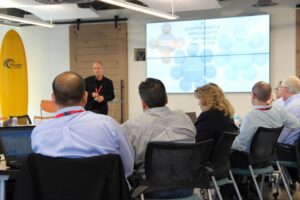The trajectory of the coronavirus (Covid-19) outbreak is making it increasingly likely that companies in major cities will be asked to increase their reliance on remote work. While the possibility of a rapid transition to remote work may seem daunting, companies can play a significant role in flattening the transmission curve of the virus.
It is possible to leverage this moment to develop higher levels of adaptability and delivery in your team. Well-run remote teams are more effective than their office-based counterparts. Because they have invested in the capacities, culture and agile mindset that drive performance, remote teams can be happier, more transparent and more productive.
Developing capacities and using frameworks from agile operations, innovation, and cultural transformation will support companies who are looking, not just to get through this temporary crisis, but actually use it as a catalyst to build a future-ready workforce.
“An agile mindset is the set of attitudes supporting an agile working environment. These include respect, collaboration, improvement and learning cycles, pride in ownership, focus on delivering value, and the ability to adapt to change.”
We have assembled a quick overview of how you can get through this temporary crisis and also use this time as a catalyst to build better teams. At the end of this post, there will be a sign up to receive our Rapid Deployment of Remote Work Playbook
Assessment:
Assess what your company needs to address when moving your team to work remotely.
- Remote Work Policy
- If your company doesn’t have a Remote Work policy – here is a great overview and template for you from Workable.
- Working remotely doesn’t change all your existing workplace policies, especially around how people conduct themselves at work, which includes biases and harassment. If you have a policy, now is a great time to review it and update language and references.
- Tools :
- Video chat – a requisite for effective collaboration ( zoom, google hangout, skype, and others).
- Chatting tools (Slack, Chatter) – for quick threaded conversations
- Project management tools (Teams, Asana, etc.)
- Shared document protocols and platforms (One drive, box, dropbox, google drive)
- Fun collaborative tools (Miro, Mural, Lucidchart and Mindmeister that enable remote brainstorming, collaborative whiteboarding, mind mapping and more).
- Presencing technology such as Owl Labs 360 camera, presencing robots like Beam (if one of your people need to stay home due to quarantine, but the rest of the team is healthy).
- Virtual Reality office – we are still not there. But imagine a future where people could log-into a shared and social virtual office to work together from their homes. There teams who are already experiencing that but the technology is still in it’s infancy and so is the adoption of such technology as a viable remote working alternative.
Strategy:
People need to have a clear purpose and outcomes that everyone understands and works towards. Deploying a remote work strategy demands the tight integration of that plan with collaborative tools. Lack of clarity about priorities and cultures that inadvertently prioritize “looking busy” over-delivering, will both be exacerbated when your team is remote.
Capacity & Skill Development:
We define high performing teams as those who are capable of adaptability and producing outcomes. There are many capacities that are common to all high performing teams and there are a few capacities that are especially important for remote teams.
Communication:
- Good communication and even over-communicating mitigate the feelings of isolation.
- When working remotely, miscommunications and missteps that result in emotional harm are easier to ignore. But small slights can compound over time, resulting in information withholds and breakdown in collaboration. Remote teams need a practice of clearing to maintain trust and productivity.
Connection and psychological safety:
- Beyond good internet connectivity, your team needs to have a good connection to one another and psychological safety. As a leader, you are accountable for your team members’ sense of safety and their engagement levels. This impacts their performance and results.
- Managers with strong coaching and facilitation skills are more likely to have the attunement needed to identify if a team member is not feeling safe or is disconnected.
Iteration and feedback:
- The agile approach means breaking tasks into smaller deliverables that are more focused, iterative and manageable. Adding to that, a cadence of team daily standup meetings and feedback in short-weekly retrospective meetings will develop a learning culture and enable managers to resolve the challenges of remote work.
Video meetings are different than in real life – like this fun video shows:
- Time-box your meetings.
- Creating a cadence in your meetings with a clear and agreed-upon agenda.
- Video meetings should be limited to an hour, so manage your agenda tightly.
Transparency:
- When working remotely, your team might feel isolated. Build transparency about what is being worked on, including clear deadlines, roles and responsibilities. Robustly used project management software will help the whole team see the bigger picture of the work that is needed to be done.
Effective Deployment & Ongoing Management:
Effective communication, quality listening and consistent messaging will support your workforce in navigating the transition and focusing on their work.
Ongoing management requires an appropriate cadence of meetings. A daily short meeting – like the agile standup – starts each day on the right foot. In our Playbook, we will go over the Connect-Scan-Focus-Act framework that supports all meetings but is especially effective for remote teams. Monday check-ins and finding a way to incorporate existing team rituals keeps it fun and supports continuity and comradery.
Stay Tuned to our transitioning Agile-Remote Teams playbook
“Preparing for the almost inevitable global spread of this virus, now dubbed COVID-19, is one of the most pro-social, altruistic things you can do in response to potential disruptions of this kind. We should prepare, not because we may feel personally at risk, but so that we can help lessen the risk for everyone. We should prepare not because we are facing a doomsday scenario out of our control, but because we can alter every aspect of this risk we face as a society”.
Scientific American





